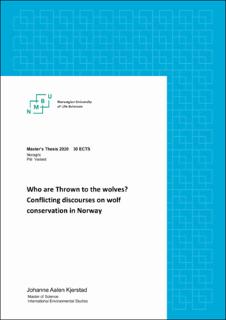| dc.description.abstract | Wolf reestablishment in Norway has been subject of controversy and the conflicts stemming from it are polarised and hostile. This thesis explores the governance of wolves in Norway, alongside the conflicts which have emerged from it, with the aim of uncovering conflict drivers as a means to enhance conflict resolution. The research aims for such through a three folded approach, investigating: the (regional) governance system; its outcomes; and the discourses which unfolds in this respective system. The Environmental Governance System Framework (EGS) outlined by Vatn (2015) is used to outline the governance system and its outcomes, whereas theories on input-and output legitimacy are applied as means to examine the legitimacy of the outcomes, particularly emphasising participation and distributive justice. Lastly, cleavage theory and different discourses are applied as tools to uncover and understand the different perspectives and interests which have emerged in the conflicts. To disclose potential conflict drivers, semi-structured qualitative interviews were carried out among relevant stakeholders in three carnivore management regions in Norway, and the findings were diverse. Findings show that the legal framework is ambiguous, and the governance system is subject to constant shifting of authority among actors. Consequently, the regional carnivore management policy is largely centralised in practice, and the lack of participation impedes legitimacy. Furthermore, the current governance system is seemingly unable to account for the costs and consequences which manifest, and conflicts and aversion arise in the wake of this. Consequently, conflicts appear particularly tense in the “wolf zone” where the majority of the wolves reside. Lastly, two dominant discourses appear to influence perceptions and attitudes, and these two discourses provide diverging rationales to different facets of the governance system. The only thing these appear to have in common, is a critical approach to the governance system, and a demand for change. Conflict resolution, does however, appear to be beyond reason until common institutions are facilitated and a sounder policy which accounts for its “losers” is implemented. | en_US |

